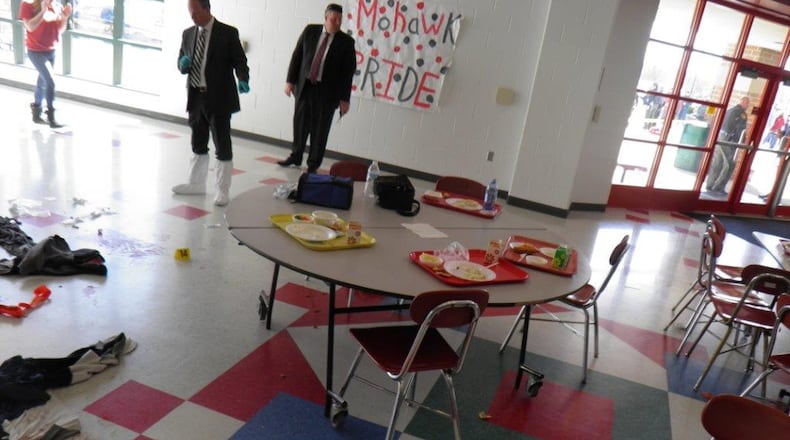And with more area districts using buildings constructed in the last 20 years, the physical layout of many local schools is now superior in terms of intruder prevention, officials said.
Wednesday’s mass shooting by a former student of Marjory Stoneman Douglas High School in Parkland, Fla. left 17 students and staffers dead and more than a dozen injured by gunfire. The gunman, identified as Nikolas Cruz, 19, was arrested shortly after the attack.
Effects of school shootings and threats have been felt locally. The last in-school shooting in Butler County was in 2016 at Madison Senior and Junior High School in Madison Township. Two students were wounded when a classmate opened fire in the school cafeteria.
On Thursday, officials at Ross High School alerted police to a social media threat referencing the Florida school shooting and a 14-year-old student from the school was arrested.
Southwest Ohio school officials make it practice to not speak publicly about the details of school building security as a precaution to keep such information from those who may be planning violence at local schools. But they said overall their local buildings are vastly better fortified than in the past.
“School security has improved significantly in the past decade and the actual design of buildings has also significantly improved the safety of our schools,” said Monroe Superintendent Phil Cagwin. “School architectural designs that invited outside visitors into open spaces at the entrance of the building are now replaced with secure entrances that require identification before being let into another secure waiting area.”
Cagwin, who started teaching in 1970s and has also been a superintendent at Butler County’s Talawanda Schools and a principal, said, “the addition of security cameras inside and outside our school buildings has also added to the safety of our schools.”
Lakota Schools Superintendent Matt Miller, who oversees the largest school district in Butler County and the largest suburban district in Southwest Ohio, said it’s not just how the schools have been upgraded but what training goes on inside.
“We have increased the number and types of safety drills our students and staff participate in, including active shooter training,” said Miller, whose district includes 22 schools and enrolls 16,500 students.
“Additionally, the number of school resource officers in our buildings has increased from three to 10. We have also improved the safe and secure entrances to all buildings.”
Warren County’s largest school system, the 11,000-student Mason Schools along the county’s southern border, has long been a leader in school security.
The district was the first locally to install photo ID security checks for visitors, dozens of security cameras and one of the first police sub stations within Mason High School, with more security advances installed this school year.
“School safety is always our top priority,” said Mason Schools Spokeswoman Tracey Carson.
“This year we’ve upgraded our entire camera system at the high school, it is much more robust now. We’ve added exterior lighting at Mason Early Childhood Center and Mason High School, and in the renovation we’ll have improved exterior lighting at Mason Intermediate School and Mason Middle School.
“And last summer, we did a joint active assailant emergency response drill, and we continue to improve our safety systems based on things we learned during the drill, as has the City (Mason Police).”
The adjacent Kings Schools has been a regular site for summer-time SWAT training drills by the Warren County Sheriff’s office.
“We definitely benefit from those trainings not only because the officers are learning the most up-to-date skills, but it makes them more familiar with our school buildings and that is a huge advantage to us as a school district if or when a crisis situation develops,” said Kings Schools Spokeswoman Dawn Gould.
“At Kings, we have gone to great lengths to have a strong school security plan,” said Gould. “We utilize a special phone app by Navigate Prepared which helps to guide us with flip charts of different crisis scenarios. We also put our staff through crisis scenarios to simulate actions to be taken during emergency situations.”
And, said Gould, “we are very fortunate to have a great relationship with the Warren County Sheriff’s Office, Deerfield Township Law enforcement and the first responders. We work very closely with them on our safety and security plans.”
Training is more important than security tech, cautions Ken Trump, president of National School Safety and Security Services and a nationally recognized expert on keeping schools safe.
“Superintendents, principals, and their crisis teams must be trained to lead in highly ambiguous and uncertain conditions,” Trump said. “They need to have strong risk and crisis communications skills. Many of the best practices learned as far back as the 1999 Columbine High School attack still apply today.”
“The question is whether school districts are making the time available to get this information to the new generation of school administrators, faculty, support staff, and school safety officials who have not been exposed to this training,” he said. “In many cases, schools are looking for the quick fix of throwing up more cameras and fortifying front entrances when we know that forensic analyses of school shootings reveal the issues to be allegations of failures of people and procedures, not failures of security products and hardware.”
About the Author
